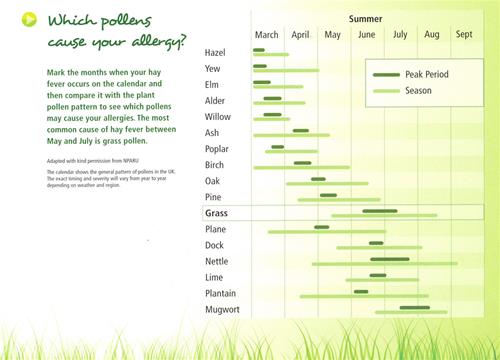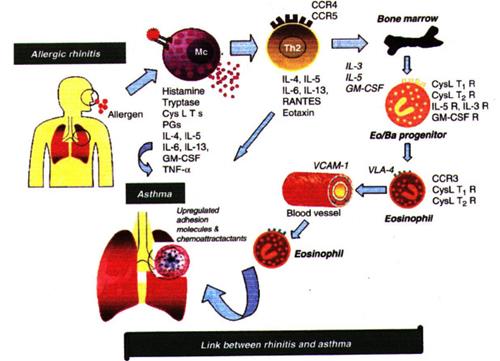Hay-fever is usually a seasonal (mid-summer) problem but can start earlier and even drag on until late autumn. Most sufferers are troubled with grass pollen only (10,000 pollen grains fit on the tip of a pin) but a significant number are troubled with a combination of tree and grass pollen allergy. Their season starts in early spring with mild nasal irritation. By the time the summer months arrive they are already compromised so that even small amounts of grass pollen can trigger quite aggressive hay-fever. If the summer is especially warm and sunny with high surges of pollen, then those three to four months can be a write-off. For those with the extra burden of mould spore allergy hay fever misery can drag on through the autumn/fall months.

Hay-fever pollen allergy causes:
Blocked nose: from swelling of the nose lining and, more especially, nose turbinates, the soft ‘shelves’ inside the nasal cavity.
Sneezing: as the nasal lining swells it becomes irritable and peppered with tiny blister-like swellings.
Runny nose: the swollen and irritable nasal lining oozes clear mucus.
Sinus pain/congestion: when the openings from nose to sinuses become blocked there is a pressure discomfort along the forehead and cheek bones.
Reduced sense of taste and smell: as the allergic challenge worsens increased swelling of the turbinates in the upper parts of the nose squeeze the nerve endings for taste and smell located there. First to go is the awareness of smell. Bizarrely bad smells fade first; you don’t notice the whiff off toilets but can appreciate perfume bouquets. However, by the time you realise you’re not getting any smells your sense of taste is probably diminished. The flavour for spice fades first. As foods taste bland unwittingly you add more salt and pepper to flavour dishes. You tolerate more chillies and spicy foods than others when dining.
Reduced hearing an intense itch in the ears and ear popping: further swelling involves the back of the throat and Eustachian tube, a narrow channel that connects to the inner ear.
Cough, wheeze and shortness of breath: as the nose and sinus inflammation irritates the lungs.
Eyes redden, itch, water and swell: as pollen grains attack the eye lining the skin underneath the lower eye lids fills with fluid making them puffy. In severe hay-fever, especially with children, the lining of the eye can be damaged from constant rubbing to relieve the intense itch. Sometimes the inner surface of the upper lids distort with what look like ‘cobble-stone’ bumps.
Itchy mouth and throat or oral-allergy syndrome: Some hay fever sufferers experience itch and swelling along the inside of the mouth, lips and tongue when they eat certain foods, especially fruit and vegetables, during the pollen season. This is due to cross sensitivity of food proteins and some pollens. For example if you’re allergic to birch tree pollen you may also react to celery, curry spices, raw tomato, raw carrot, apples, pears, cherry, hazelnut, almond and kiwi fruit. If you’re allergic to grass pollen you may react to oats, rye, wheat, kiwi fruit and raw tomato. Ragweed pollen allergy may trigger symptoms when eating banana, cucumber, melon, zucchini/courgette, sunflower seeds, chamomile tea or Echinacea.
If even 50% of these symptoms occur hay-fever sufferers feel exhausted and drained of all energy.
Symptom summary:
- Sneezing
- Blocked and runny nose
- Sinus congestion with headaches, especially along the forehead
- Itchy, red and watery eyes
- Puffy eyes and lower eyelids
- Cough and occasional wheeze
- Ears popping with occasional hearing impairment
- Diminished senses of taste and smell (severe hay-fever sufferers)
- Itch along roof of mouth and back of throat when eating certain foods
- Feeling of intense lethargy
Self-help tips:
- Download Hay Fever Relief app (www.hayfever-relief.com) and check your score every day throughout the pollen season and use the tips to stay well. It’s a 3D interactive dramatic imagery concept that’s received wide praise.
- Avoid areas of lush grassland
- Keep house and car windows closed during peak pollen hours of late morning and late afternoon
- Wear wrap-around sunglasses to reduce pollen grains affecting the eyes
- If you can, avoid being outdoors late morning and late afternoon
- Don’t smoke and keep away from smokers (passive smoking aggravates all allergies)
- Get someone else to mow the lawn or wear a face mask if you have to cut the grass.
- Choose seaside breaks for holidays as off shore breezes blow pollen away
- Check TV, radio and newspapers for the next day’s pollen count and plan your schedule accordingly
- Put a smear of Vaseline inside each nostril to ease the soreness and to capture pollen entering the nasal passages.
- Never sleep with the bedroom window open.
- Don’t drive with the window open.
- Put used tea bags in the fridge. They make great soothing compresses to relieve swollen or puffy eyes.
- Keep an antihistamine handy for sudden allergy attacks
Pollen season:

Your pollen season misery varies depending on where you live and what you’re allergic to. Pollen from perennial rye and timothy grasses circulate throughout Europe. Some types of pollen are only found in specific locations: Northern hemisphere, here birch tree is the main nuisance. North America, ragweed causes much nose and sinus allergy as does Parietaria (a grassy plant commonly found in urban areas). Parietaria and olive tree pollens disperse in Mediterranean countries; Japanese cedar pollen allergy is only found in Japan.
Allergy triggering plants/trees in Europe are divided into five areas:
- Northern Europe: birch tree and grasses
- Central Europe: deciduous forest trees, birch tree and grasses
- Eastern Europe: grasses, mugwort weed and ragweed
- Mountaineous Europe: grass and tree pollens
- Mediterranean Europe: grass pollen, Parietaria (a grassy plant commonly found in urban areas), olive and cypress tree pollens
In northern, central and eastern Europe, the main grass pollen season starts at the beginning of May and finishes at the end of July.
In Mediterranean countries there are three pollen seasons:
December – March from cypress, juniper, hazel, momosa and birch tree pollen surges. April – July grass pollen diminates alsong with nettle and olive tree pollen. March – May other tree pollens (such as American sycamore) irritate susceptible noses. August – October can be a nuisance with the second flowering of nettle and mugwort weed.
In the UK and Ireland aggressive sneezes can be heard first along the warmer western coasts. By the end of May high pollen counts can detected countrywide (the pollen count measures the amount of pollen in the air over 24 hours). Pollen allergy misery can change with weather -related production, dispersal and quantity of pollen grains in the air. Grass pollen surges about 2 – 3 weeks earlier at sea level compared to mountainous areas. High levels of pollen occur on warm, dry and sunny days. Low levels occur on wet, damp and cold days. Rain washes pollen out of the air. Pollen is released in the morning and carried higher into the air by midday. It descends again to ‘nose-level’ in the late afternoon. Cities and dense urban areas stay warmer longer and hold pollen. Combine this with atmospheric pollution from car fumes and you can understand why city dwellers suffer more aggressive hay-fever than their country cousins.
Hay fever and asthma link
Aggressive hay-fever causes both nose and sinus inflammation. However the nose and sinuses link to the lungs by a number of pathways that include nerve ending and asthma triggering blood units (called Th2). These move from the nose and sinuses to the bone marrow to produce a number of allergy chemicals which move into the blood circulation and ‘stick’ in the nose, sinuses and lungs, causing further allergic inflammation that triggers cough and wheeze.

- Hay-fever may cause nose symptoms only.
- Hay-fever often involves the sinuses as well as the nose.
- Hay-fever may provoke chest symptoms.
- Hay-fever may go hand-in-hand with asthma.
- Hay-fever in children with asthma causes more asthma-related hospital admissions and greater total days spent in hospital
Thunderstorms and asthma attacks
Thunderstorms during the pollen season can trigger asthma attacks ranging from mild to life threatening. Pollen grains are carried at ground level by the strong air currents in thunderstorms. Then the pollen grains burst, releasing their allergy provoking material (called allergens). The allergens are carried as aerosols in the wind currents and easily inhaled, penetrating deeply into the nose and sinuses and lungs triggering breathing crises. For some hay-fever sufferers this may be the first time they’ve ever experienced asthma.
Such events have been reported in Birmingham and London in the UK, Naples in Italy and Melbourne and Wagga Wagga in Australia.








